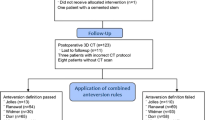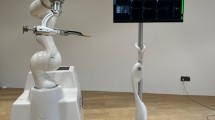Abstract
Purpose
The purpose of this study was to compare non-fiducial based surface registration technique (DigiMatch) with the conventional locator pin-based registration technique in performing cementless total hip arthroplasty (THA) using ROBODOC system.
Methods
Eighty-one THA were performed using pin-based technique and forty-three were performed using the DigiMatch technique. The average follow-up term was 38 months.
Results
Postoperatively, the Japanese Orthopedic Association hip scores were significantly better in the DigiMatch group than in pin-based group. The accuracy of postoperative stem alignment of the DigiMatch technique was comparable with that of pin-based method.
Conclusions
No need for prior pin implantation surgery and no concern for pin related knee pain were the advantages of DigiMatch technique. Short-term follow-up clinical results showed that DigiMatch ROBODOC THA was safe and effective.
Similar content being viewed by others
References
Amin DV, Kanade T, DiGioia AM 3rd et al (2003) Ultrasound registration of the bone surface for surgical navigation. Comput Aided Surg 8(1): 1–16. doi:10.3109/10929080309146097
Brooker AF, Bowerman JW, Robinson RA et al (1973) Ectopic ossification following total hip replacement. Incidence and a method of classification. J Bone Joint Surg Am 55(8): 1629–1632
Crowe JF, Mani VJ, Ranawat CS (1979) Total hip replacement in congenital dislocation and dysplasia of the hip. J Bone Joint Surg Am 61(1): 15–23
Dorr LD (1985) Optimizing results of total joint arthroplasty. Instr Course Lect 34: 401–404
Engh CA, Bobyn JD, Glassman AH (1987) Porous-coated hip replacement. The factors governing bone ingrowth, stress shielding, and clinical results. J Bone Joint Surg Br 69(1): 45–55
Engh CA, Glassman AH, Suthers KE (1990) The case for porous-coated hip implants. The femoral side. Clin Orthop Relat Res 261: 63–81
Glozman D, Shoham M, Fischer A (2001) A surface-matching technique for robot-assisted registration. Comput Aided Surg 6(5): 259–269
Herring JL, Dawant BM, Maurer CR Jr et al (1998) Surface-based registration of CT images to physical space for image-guided surgery of the spine: a sensitivity study. IEEE Trans Med Imaging 17(5): 743–752. doi:10.1109/42.736029
Honl M, Dierk O, Gauck C et al (2003) Comparison of robotic-assisted and manual implantation of a primary total hip replacement. A prospective study. J Bone Joint Surg Am 85(8): 1470–1478
Nishihara S, Sugano N, Nishii T et al (2006) Comparison between hand rasping and robotic milling for stem implantation in cementless total hip arthroplasty. J Arthroplasty 21(7): 957–966. doi:10.1016/j.arth.2006.01.001
Nogler M, Maurer H, Wimmer C et al (2001) Knee pain caused by a fiducial marker in the medial femoral condyle: a clinical and anatomic study of 20 cases. Acta Orthop Scand 72(5): 477–480. doi:10.1080/000164701753532808
Paul HA, Bargar WL, Mittlestadt B et al (1992) Development of a surgical robot for cementless total hip arthroplasty. Clin Orthop Relat Res 285: 57–66
Schicho K, Figl M, Seemann R et al (2007) Comparison of laser surface scanning and fiducial marker-based registration in frameless stereotaxy. Technical note. J Neurosurg 106(4): 704–709. doi:10.3171/jns.2007.106.4.704
Schulz AP, Seide K, Queitsch C et al (2007) Results of total hip replacement using the Robodoc surgical assistant system: clinical outcome and evaluation of complications for 97 procedures. Int J Med Robot 3(4): 301–306. doi:10.1002/rcs.161
Shima Y (1971) Present status of surgical treatment of arthrosis deformans of the hip and summary of therapeutic evaluation. Nippon Seikeigeka Gakkai Zasshi 45(10): 828–831
Sugano N, Sasama T, Sato Y et al (2001) Accuracy evaluation of surface-based registration methods in a computer navigation system for hip surgery performed through a posterolateral approach. Comput Aided Surg 6(4): 195–203
Tamura Y, Sugano N, Sasama T et al (2005) Surface-based registration accuracy of CT-based image-guided spine surgery. Eur Spine J 14(3): 291–297. doi:10.1007/s00586-004-0797-y
Author information
Authors and Affiliations
Corresponding author
Rights and permissions
About this article
Cite this article
Nakamura, N., Sugano, N., Nishii, T. et al. Robot-assisted primary cementless total hip arthroplasty using surface registration techniques: a short-term clinical report. Int J CARS 4, 157–162 (2009). https://doi.org/10.1007/s11548-009-0286-1
Received:
Accepted:
Published:
Issue Date:
DOI: https://doi.org/10.1007/s11548-009-0286-1




